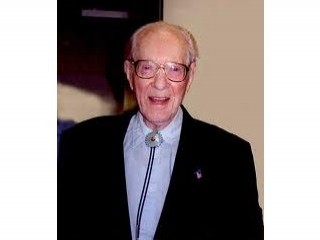
Fred Whipple biography
Date of birth : 1906-11-05
Date of death : 2004-08-30
Birthplace : Red Oak, Iowa, United States
Nationality : American
Category : Arhitecture and Engineering
Last modified : 2011-12-22
Credited as : astronomer, Whipple shield, astronomy
1 votes so far
Born in 1906 to farmers, Whipple had no intentions as a youth of becoming an astronomer. Instead he wanted to be a professional tennis player. His dreams were shattered, however, when he caught polio, which left him in no shape to play sports professionally. The Whipples moved to Los Angeles when young Fred was 15. There he attended Long Beach High School before he went on to the University of California, Los Angeles, where he received his bachelor's degree in mathematics in 1927. It was a class he took during his undergraduate studies that turned him toward a career in astronomy. Such was his interest that Whipple went on to the University of California at Berkeley to get a Ph.D. in astronomy in 1931. While finishing up his Ph.D. Whipple helped to map the orbit of the planet Pluto, which at the time had just been discovered. After his graduation he accepted a position at Harvard University. He started out as an instructor, then moved on to the positions of lecturer in 1938, associate professor in 1945, and professor in 1950.
During World War II Whipple invented a device to aid Allied planes. The device, which basically dropped bits of aluminum from a plane, fooled enemy radar into thinking that there were a larger number of planes flying than were actually there, making it impossible for them to tell where the real planes were. It worked very well. In 1946 he invented something that later became known as the Whipple Shield. There were already discussions of future space flights and one of the problems facing scientists was the idea of meteors hitting the space crafts and injuring them. The Whipple Shield, a thin outer skin of metal, served as a bumper, disintegrating any meteors, leaving only vapor to hit the spacecraft. It was still in use in 2005.
Whipple made his name, however, as a pioneer who proposed the dirty snowball theory for the substance of comets. Comets had perplexed scientists since they were first discovered, but it was not until Whipple proposed his theory in 1950—the idea that comets consisted of ice and rock, rather than sand held together by gravity as had been previously thought, or rocks thrown out into space by volcanoes on Saturn or Jupiter—that scientists really began to understand the comets' nature. The theory helped explain why some comets arrived earlier or later at certain destinations than predictions said they would. This was because as comets got closer to the sun, the light vaporized ice in the comet's nucleus. This too would explain why there were jets, or tails, shooting out from the comets; they were the particles that had been vaporized by the sun's rays. These tails, in turn, would act like jets, either speeding up or slowing down the comet, depending on the direction the tail was pointed in—either toward or away from the line of travel. Whipple theorized this, amazingly enough, with very little data to go on. As Mike Lecar, an astrophysicist at Whipple's old stomping grounds said to Maugh and Zarembo in the Los Angeles Times, "Unlike other great physicists, he had uncommon common sense . He just looked at things with a fresh eye." Whipple's theories were proven correct in 1986 when the European Space Agency's Giotto spacecraft took close-up photos of Haley's comet. In the 1950s Whipple's advice on scientific things was sought after and he became a consultant to Collier's magazine for articles about space exploration, along with his rocket scientist friends Willy Ley and Wernher von Braun. Also, in 1955 Whipple became the director of the Smithsonian Astrophysical Observatory in Cambridge.
In 1963 President John F. Kennedy gave Whipple an award for distinguished public service for a project that Whipple had invented using a network of cameras to track the Soviet Union's new Sputnik satellite. Whipple also arranged another type of observation group, consisting of amateur astronomers. He foresaw the coming satellite age, and set up America to be in a position to observe and guard against it. When Sputnik was eventually launched, America was the only country able to watch and track the satellite, and only because of Whipple's work.
Whipple continued as the director of the Smithsonian Astrophysical Observatory until 1973. At that point the Observatory merged with the Harvard Observatory and was renamed the Harvard-Smithsonian Center for Astrophysics. He retired from Harvard in 1977, although he biked to the center six days a week until he was 90. He also wrote a standard textbook for his field called Earth, Moon, and Planets, and has been credited with the discovery of six comets. According to Adam Bernstein in the Washington Post, "An observatory in Arizona and an asteroid were named in his honor." He received many awards and was seen on postage stamps in Mauritania in 1986 and St. Vincent in 1994. He was also a member of the Royal Society of Arts in London.
In 1999 Whipple was asked to take part in the National Aeronautics and Space Administration's comet nucleus tour (CONTOUR) group. He was the oldest man ever to accept such an assignment. The spacecraft that was designed is scheduled to meet up with Comet Schwassmann-Wachmann 3 in June of 2006. His fellow designers were saddened because Whipple did not live long enough to see this happen, as Whipple died on August 30, 2004, in Cambridge, Massachusetts; he was 97. He married Dorothy Woods Whipple in 1928, and the couple had one son, Earle Raymond, before they were divorced. He married Babette Samuelson Whipple in 1946, and Whipple is survived by her, his son, and two daughters, Sandra and Laura, from his second marriage.
















